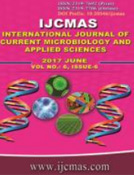


 National Academy of Agricultural Sciences (NAAS)
National Academy of Agricultural Sciences (NAAS)

|
PRINT ISSN : 2319-7692
Online ISSN : 2319-7706 Issues : 12 per year Publisher : Excellent Publishers Email : editorijcmas@gmail.com / submit@ijcmas.com Editor-in-chief: Dr.M.Prakash Index Copernicus ICV 2018: 95.39 NAAS RATING 2020: 5.38 |
A total of (80) samples of living diseased cultured Tilapia fish (Oreochromus niloticus), were collected from different fish farms in Egypt (Behera and Kafr El-Sheikh) which showed the clinical signs of loss of scales from some areas of the skin, excessive mucus all over the body surfaces with petechial haemorrhages over the dorsal musculature, large necrotic lesions extending all over the body and darkness of skin. Differentiation and characterization of various isolates was based on their growth characteristics on specific culture media (biochemical and gram staining reactions). The following human pathogenic bacteria were isolated Staph. aureus, Staph. epidermidis, Staph. Saprophytics, Streptococcus spp., E. coli, Salmonella, P. aeruginosa, P. fluorescens, and Enterobacteriaceae from skin with the incidence of 12.5%, 23.8%, 31.3%, 10%, 25%, 7.5%, 22.5%, 20%, and 18.8% respectively, but from muscle with the incidence of 7.5%, 7.5%, 12.5%, 8.8%, 22.5%, 5%, 20%, 18.8%, and 16.3% respectively. On the other hand these bacteria isolated from intestine with the incidence of8.8%, 7.5%, 12.5%, 13.8%, 25%, 8.8%, 17.5%, 15%, and 16.3% respectively, while from liver with incidence of 15%, 12.5%, 16.3%, 15%, 35%, 6.3%, 25%, 23.8%, and 15% respectively. In vitro sensitivity test indicated that, the most prevalent bacteria isolated from examined fish samples were sensitive to enrofloxacin, norfloxacin, ciprofloxacin and kanamycin. Most of these strains were highly resistant to erythromycin and a moxycillin. PCR panel could help for rapid diagnoses to determine the causative agents from fish samples, Staph. aureus coagulase gene and variable fragments for 16SrRNA genes from the extracted DNA at 228bp.
 |
 |
 |
 |
 |